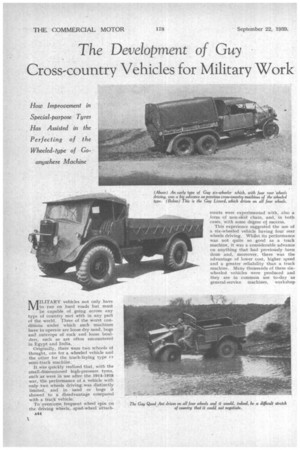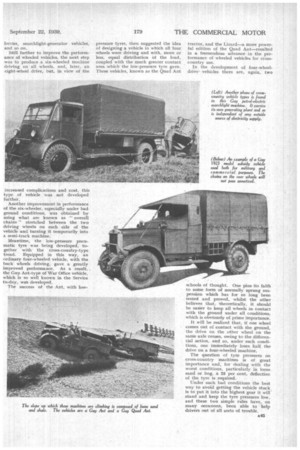The Development of Guy Cross-country Vehicles for Military Work
Page 46

Page 47

If you've noticed an error in this article please click here to report it so we can fix it.
How Improvement in Special-purpose Tyres Has Assisted in the Perfecting of the Wheeled-type of Go anywhere Machine
MILITARY vehicles not only have to run on hard roads but must be capable of going across any type of country met with in any part of the world. Three of the worst conditions under which such machines have to operate are loose dry sand, bogs and outcrops of rock and loose boulders, such as are often encountered in Egypt and India.
Originally, there were two schools of thought, one for a wheeled vehicle and the other for the .track-laying type cr semi-track machine.
It was quickly realized that, with the small-dimensioned high-pressure tyres, such as were in use after the 1944-1918 war, the performance of a vehicle with only two wheels driving was distinctly limited, and in sand or bogs it showed to a disadvantage compared with a track vehicle.
To overcome frequent wheel spin on the driving Wheels, spud-wheel 'attachA44
ments were experimented with, also a form of non-skid chain, and, in both cases, with some degree of success. This experience suggested the use of a six-wheeled vehicle having four rear wheels driving. Whilst its performance was not quite so good as a track machine, it was a considerable advance on anything that had previously been done and, moreover, there was the advantage of lower cost, higher speed and a greater reliability than a track machine. Many thousands of these sixwheeled vehicles were produced and they are in common use to-day as general-service machines, workshop
lorries, searchlight-generator vehicles, and so on.
Still further to improve the performance of wheeled vehicles, the next step was to produce a six-wheeled machine driving on all wheels, and, later, an eight-wheel drive, but, in view of the increased complications and cost, this type of vehicle was not developed further.
Another improvement in performance of the six-wheeler, especially under bad ground conditions, was obtained by using what are known as " overall chains " stretched between the two driving wheels on each side of the vehicle and turning it temporarily into a semi-track machine.
Meantime, the low-pressure pneumatic tyre was being developed, together with the cross-country-type tread. Equipped in this way, an ordinary four-wheeled vehicle, with the back wheels driving, gave a greatly improved performance. As a result,. the Guy. Ant-type of War Office vehicle, which is so well known in the Service to-day, was developed.
The success of the Ant, with low pressure tyres, then suggested the idea of designing a vehicle in which all four wheels were driving and with, more or less, equal distribution of the load, coupled with the much greater contact area which the low-pressure tyre gave. These vehicles, known as the Quad Ant tractor, and the Lizard—a more powerful edition of the Quad Ant—resulted in a tremendous advance in the performance of wheeled vehicles for crosscountry use.
In the development of four-wheeldrive' vehicles there are, again, two schools of thought. One pins its faith to some form of normally sprung suspension which has for so long been tested and proved, whilst the other believes that, theoretically, it should be easier to keep all wheels in contact with the ground under all conditions, which is obviously of prime importance.
It will be realized that, if one wheel comes out of contact with the ground, the drive on the other wheel on the same axle ceases, owing to the differential action, and so, ander such conditions, one immediately loses half the drive on a four-wheeled machine.
The question of tyre pressures on cross-country machines is of great importance and, for dealing with the worst conditions, particularly in loose sand or bog, a 25 per cent. deflection of the tyre is required. • Under such bad conditions the best way to avoid getting the vehicle stuck is to put it into the highest gear it will stand and keep the tyre pressures low, and these two simple rules have, on many occasions, been able to help drivers out of all sorts of trouble,




































































